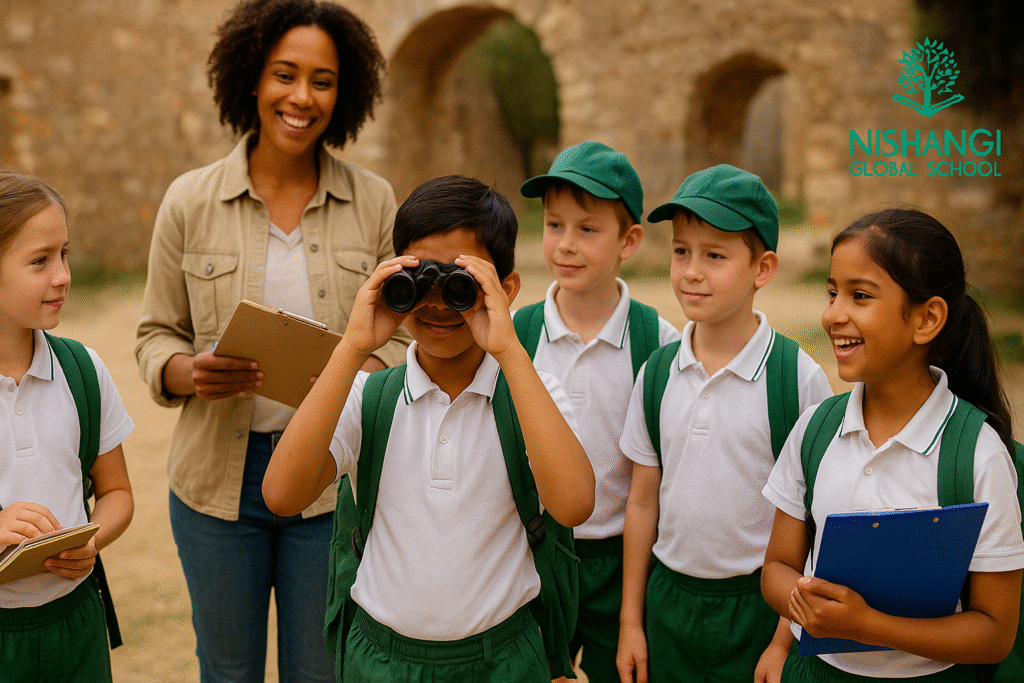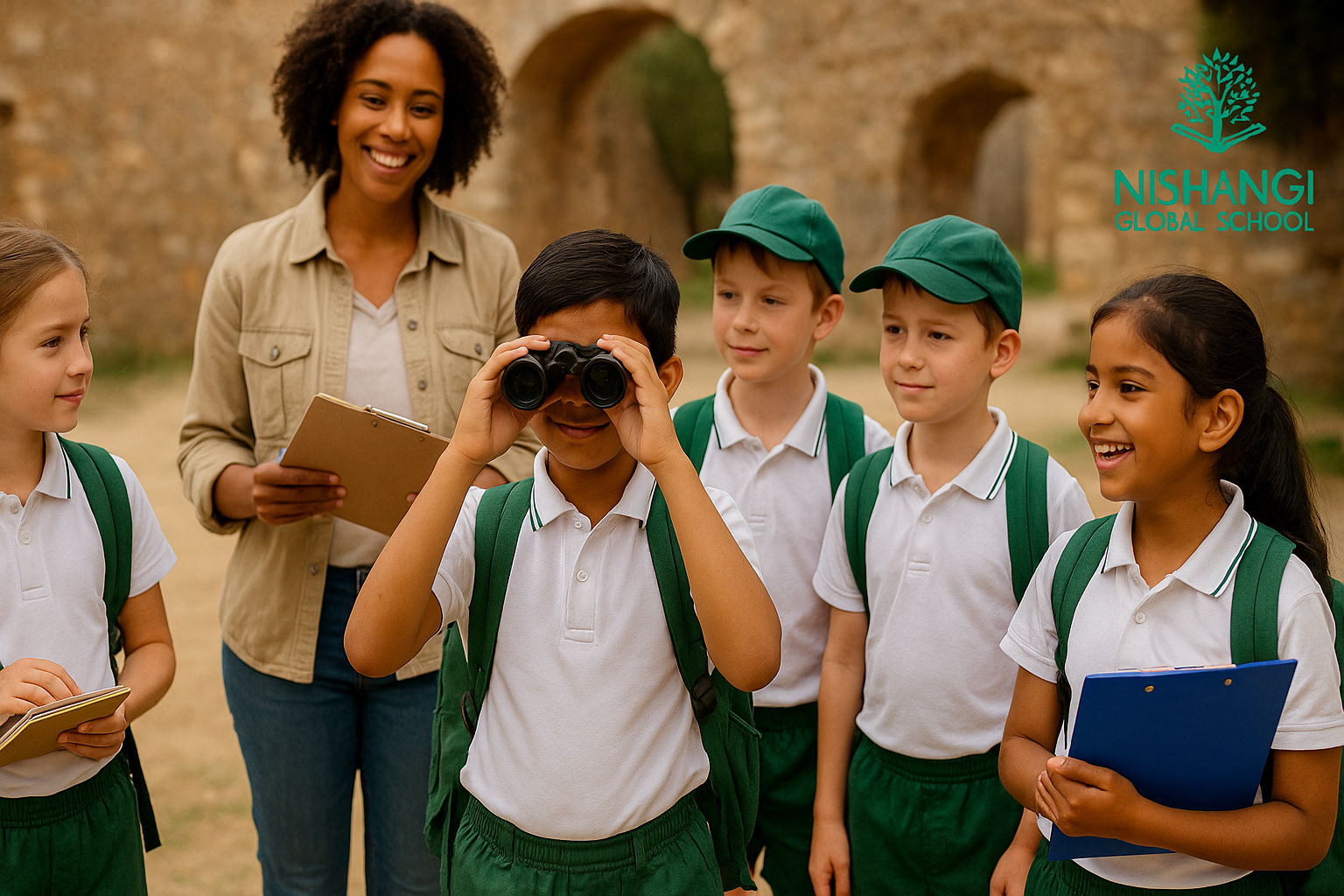
At Nishangi Global School, we believe that education does not stop at the classroom walls. True learning happens when students walk outside, see the world with their eyes, hear stories in new voices, touch objects from history or nature, and ask questions that textbooks cannot always answer. Our Excursions & Field Trip Program is designed to bridge this gap—to take lessons from theory into the real world. In this article, we explore how past excursions reaffirm our belief in experiential learning, the rich learning outcomes we observe, and why real‑world exposure makes classroom learning more vibrant, memorable, and meaningful.
What Are We Doing: Examples of Nishangi Excursions & Field Trips
Here are some illustrative examples of the kinds of excursions Nishangi Global School organizes, and how they are structured to serve learning goals.
- Cultural Immersion Journeys
Students often visit museums, art galleries, and heritage sites in Hyderabad and beyond. For example, a visit to a local museum lets students see artifacts, paintings, sculptures, and multimedia exhibits that correspond with their history or art classes. Heritage sites—old forts, palaces, temples, monuments—bring alive stories of past rulers, architecture styles, craft traditions, and city planning of earlier eras. These trips go beyond rote learning to help students feel the culture, see craftsmanship, and understand how history shaped today. - Nature & Environment Expeditions
Another important strand of our field programs are nature expeditions—nature reserves, botanical gardens, ecological parks, and similar outdoors settings. In some trips, students collect leaves, observe insects, record different plant species, study water bodies, and participate in guided tours about biodiversity, conservation, and sustainability. These include hands‑on activities: observing, sketching, classifying, sometimes even simple experiments or environmental projects. - Educational & Scientific Outings
Trips to science centres, planetariums, technology labs, or workshops are part of our experiential learning. For instance, when students learning about astronomy visit a planetarium, they see constellations, planetary models, and simulations. In science labs or technology workshops, students may try experiments, see equipment or phenomena in action, beyond what is shown in textbooks. - Community & Local Learning Experiences
We also take students to places in the city that connect with everyday life—local businesses, farms, markets, local heritage walks, botanical gardens in the city, or nature parks close by. These trips help students understand how their classroom lessons apply to their community. For example, mathematics becomes more real when measuring plants or mapping trails; environmental science comes alive when examining local water bodies or green cover.
Learning Outcomes: What Students Gain
Field trips aren’t just fun days off—they are carefully planned parts of the curriculum, aiming for specific learning outcomes. Based on our observations at Nishangi and what educational research shows, here are the key outcomes:
1. Deeper Understanding & Retention
When students see or touch what they are studying, learning sticks better. Concepts from history, science, geography become less abstract. For example, a lesson on plant life cycles becomes much more vivid when students can examine actual leaves, identify seeds, observe insects that pollinate the plants during a garden expedition. Seeing the real object, not just diagrams, helps memory and comprehension.
2. Multisensory Learning
Field trips engage more senses than typical classroom work: sight, sound, smell, touch—and sometimes taste. A nature walk might include the aroma of soil after rain, rustling leaves, chirping birds, or textured bark—which add layers to learning. Students are more engaged; it’s not just listening and writing, but smelling, observing, asking, interacting.
3. Development of Inquiry, Critical Thinking & Problem‑Solving Skills
Real‑world settings throw up unexpected observations and questions. Why is this plant species only here? What does this architectural style tell us about the climate, resources, or culture of that era? How does urban planning meet the needs of people? Students learn to ask “why not”, “how”, “what if” questions. They make connections between what textbooks say and what they see, which builds analytical thinking.
4. Social & Emotional Growth
Field trips encourage teamwork, cooperation, empathy, and growth in interpersonal skills. Students plan together, help each other during walks or group tasks, share responsibilities (e.g. carrying materials, giving presentations). Being outside their usual classroom comfort zones helps build confidence. It may also deepen empathy—when students see environmental degradation, cultural heritage, or interact with different communities, their worldview can broaden.
5. Motivation, Engagement & Curiosity
Many students report that lessons become more exciting after a field trip. Seeing something for real sparks curiosity. It motivates them to ask more questions, perhaps do more reading, or explore related topics independently. Enthusiasm generated in the field often carries back into the classroom, improving participation, assignments, and even performance.
6. Real‑World Connection & Relevance
Field trips anchor textbook knowledge to real life. When students learn about trade, environment, culture, technology, seeing these in action helps them understand how their learning is relevant. They learn not just “what” but “why” it matters. For example, understanding conservation is important not just as theory but as practices affecting villages, cities, ecosystems around them.
How Real‑World Exposure Complements Classroom Learning
To maximize benefit, the field‑trip experience is integrated with classroom instruction. Here’s how we ensure complementarity:
A. Pre‑Trip Preparation
Before going out, teachers prepare students with context: what they’ll see, key questions, background knowledge, vocabulary. For example, before visiting a heritage site, students may study its history, architectural style, key personalities associated. This scaffolding helps students get more out of the trip rather than being passive observers.
B. Guidance & Structured Activities During Trip
Rather than just free wandering, our excursions include guided tours, worksheets or scavenger hunts, group tasks, photography or sketching assignments, reflective questions. These help students focus, observe carefully, compare and record, making the trip purposeful.
C. Post‑Trip Reflection & Project Work
After returning, students share their observations: presentations, creative writing, posters, model‑making, or art. They reflect: what surprised them, what they learned, how things differed from what they expected. These reflections help consolidate learning, foster critical thinking, and allow teachers to assess outcomes.
D. Connecting to Curriculum
Teachers align trip experiences with curriculum goals: science, history, geography, environmental studies, art. For instance, a botanic garden visit ties into biology; a museum visit connects to history; heritage walks link to social studies, architecture or culture.
Examples of Impact: Stories from Nishangi
Here are some hypothetical or gathered examples of how our students have benefitted from past excursions. (Based on what we have seen in schools with similar programs, and aligning with our school’s activities.)
- Exploring Cultural Heritage: Students who visited a historical landmark in Hyderabad reported that their understanding of dynasties, architecture, and local culture became vivid. They could identify elements of Islamic, colonial, and indigenous architecture in buildings, which previously seemed like names and dates in textbooks.
- Nature Expedition: During a botanical garden trip, students participating in environmental science projects identified over 20 plant species, observed pollinators, and studied soil samples. One group created a small project for water conservation at home after seeing how local water bodies are managed.
- Science Centre Outing: Students visiting a science museum interacted with hands‑on exhibits — optics, physics demonstrations, robotics labs. It inspired many to ask deeper questions; some initiated class projects on robotics or coding afterward.
- Local Community Visits: Visiting local farms or markets helped students see supply chains, economics, agriculture in action. Math lessons on measures, weights, profit/loss, fractions became more concrete when used in real money/market contexts.
- Art & Gallery Visit: A gallery trip gave art students exposure to real paintings, contemporary art, sculpture, installations. Students were able to discuss colours, technique, media, expressions. Then in class, they attempted mixed media art inspired by what they saw, improving both creativity and technical skills.
Planning & Best Practices: Ensuring Every Trip is Safe, Meaningful, and Memorable
Field trips require careful planning to reap full benefit. Here’s how Nishangi ensures every excursion is valuable:
- Clear Learning Objectives
Each trip has defined goals: what students should learn, what skills they should develop, what outcomes expected. This helps design pre‑trip and post‑trip activities. - Safety & Logistics Planning
Permission forms, safety protocols, transport arrangements, supervision counts, emergency plans are all arranged in advance. Students briefed on behaviour, safety, what to carry, what to expect. - Teacher & Staff Preparation
Teachers prepare materials and background, plan questions; sometimes experts or guides are involved to deepen the accuracy of learning. - Small Group Tasks / Reflection Tools
Use group work, guided questionnaires, creative assignments to ensure active participation and deeper learning. - Integration with Curriculum
Teachers tie trip content back to classroom curriculum—both before and after—to make learning coherent. - Feedback & Evaluation
After the trip, evaluating what worked and what didn’t helps improve future outings. Student reflections, teacher debrief, parent feedback help.
Why This Matters: The Long‑Term Impact
The effects of regular field trips & excursions go beyond just a single memorable day. Here’s why this matters for students’ long‑term growth:
- Students who have rich, hands‑on experiences are better prepared for future education, which often demands problem‑solving, collaboration, adaptability.
- Early exposure to cultural, scientific, environmental settings often shapes interests, sometimes careers (for example, a student fascinated by plants may pursue biology or environmental science).
- These experiences build confidence, adaptability, tolerance for ambiguity—qualities that are often needed in real‑world settings, workplaces, in higher studies.
- Social skills and empathy developed as students interact in less structured, more diverse environments help them become more well‑rounded citizens.


